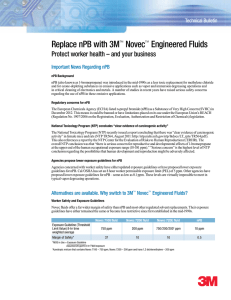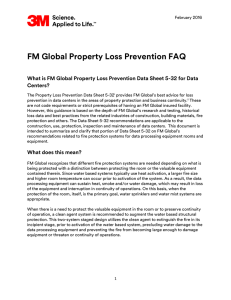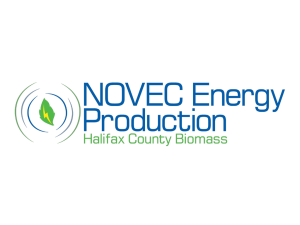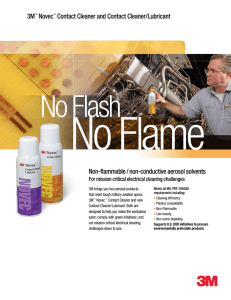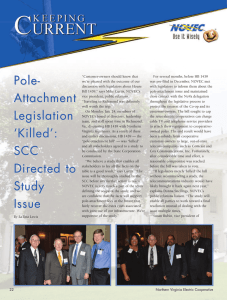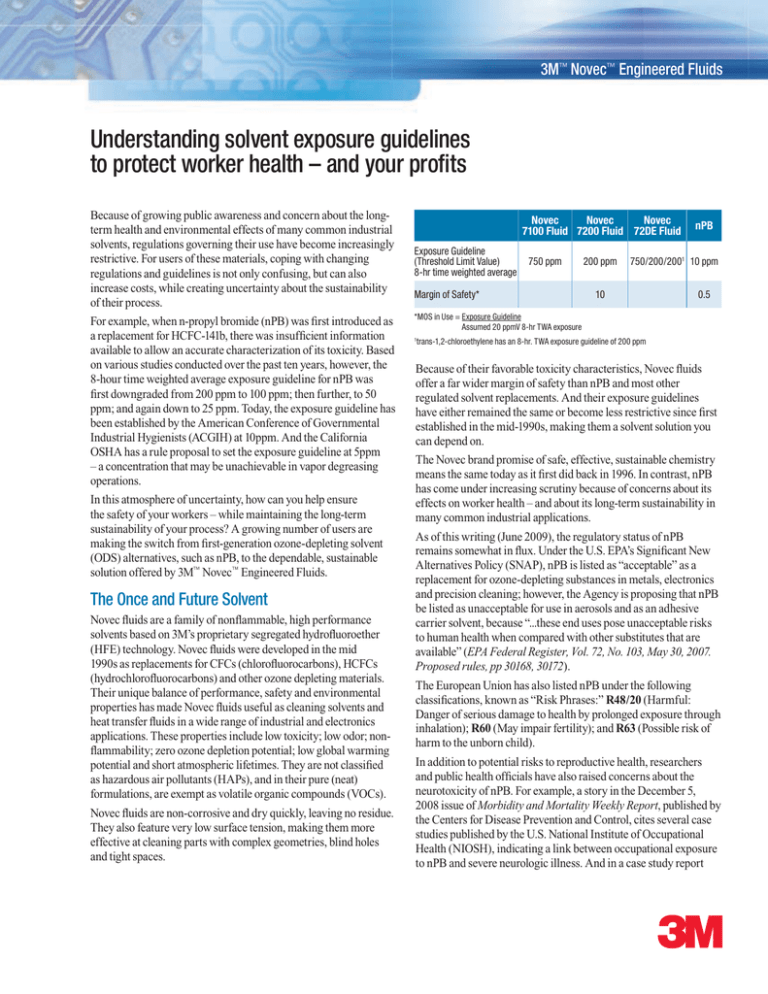
3M™ Novec™ Engineered Fluids
Understanding solvent exposure guidelines
to protect worker health – and your profits
Because of growing public awareness and concern about the longterm health and environmental effects of many common industrial
solvents, regulations governing their use have become increasingly
restrictive. For users of these materials, coping with changing
regulations and guidelines is not only confusing, but can also
increase costs, while creating uncertainty about the sustainability
of their process.
For example, when n-propyl bromide (nPB) was first introduced as
a replacement for HCFC-141b, there was insufficient information
available to allow an accurate characterization of its toxicity. Based
on various studies conducted over the past ten years, however, the
8-hour time weighted average exposure guideline for nPB was
first downgraded from 200 ppm to 100 ppm; then further, to 50
ppm; and again down to 25 ppm. Today, the exposure guideline has
been established by the American Conference of Governmental
Industrial Hygienists (ACGIH) at 10ppm. And the California
OSHA has a rule proposal to set the exposure guideline at 5ppm
– a concentration that may be unachievable in vapor degreasing
operations.
In this atmosphere of uncertainty, how can you help ensure
the safety of your workers – while maintaining the long-term
sustainability of your process? A growing number of users are
making the switch from first-generation ozone-depleting solvent
(ODS) alternatives, such as nPB, to the dependable, sustainable
solution offered by 3M™ Novec™ Engineered Fluids.
The Once and Future Solvent
Novec fluids are a family of nonflammable, high performance
solvents based on 3M’s proprietary segregated hydrofluoroether
(HFE) technology. Novec fluids were developed in the mid
1990s as replacements for CFCs (chlorofluorocarbons), HCFCs
(hydrochlorofluorocarbons) and other ozone depleting materials.
Their unique balance of performance, safety and environmental
properties has made Novec fluids useful as cleaning solvents and
heat transfer fluids in a wide range of industrial and electronics
applications. These properties include low toxicity; low odor; nonflammability; zero ozone depletion potential; low global warming
potential and short atmospheric lifetimes. They are not classified
as hazardous air pollutants (HAPs), and in their pure (neat)
formulations, are exempt as volatile organic compounds (VOCs).
Novec fluids are non-corrosive and dry quickly, leaving no residue.
They also feature very low surface tension, making them more
effective at cleaning parts with complex geometries, blind holes
and tight spaces.
Novec
Novec
Novec
7100 Fluid 7200 Fluid 72DE Fluid
Exposure Guideline
(Threshold Limit Value)
8-hr time weighted average
750 ppm
Margin of Safety*
200 ppm
nPB
750/200/2001 10 ppm
10
0.5
*MOS in Use = E xposure Guideline
Assumed 20 ppmV 8-hr TWA exposure
trans-1,2-chloroethylene has an 8-hr. TWA exposure guideline of 200 ppm
1
Because of their favorable toxicity characteristics, Novec fluids
offer a far wider margin of safety than nPB and most other
regulated solvent replacements. And their exposure guidelines
have either remained the same or become less restrictive since first
established in the mid-1990s, making them a solvent solution you
can depend on.
The Novec brand promise of safe, effective, sustainable chemistry
means the same today as it first did back in 1996. In contrast, nPB
has come under increasing scrutiny because of concerns about its
effects on worker health – and about its long-term sustainability in
many common industrial applications.
As of this writing (June 2009), the regulatory status of nPB
remains somewhat in flux. Under the U.S. EPA’s Significant New
Alternatives Policy (SNAP), nPB is listed as “acceptable” as a
replacement for ozone-depleting substances in metals, electronics
and precision cleaning; however, the Agency is proposing that nPB
be listed as unacceptable for use in aerosols and as an adhesive
carrier solvent, because “...these end uses pose unacceptable risks
to human health when compared with other substitutes that are
available” (EPA Federal Register, Vol. 72, No. 103, May 30, 2007.
Proposed rules, pp 30168, 30172).
The European Union has also listed nPB under the following
classifications, known as “Risk Phrases:” R48/20 (Harmful:
Danger of serious damage to health by prolonged exposure through
inhalation); R60 (May impair fertility); and R63 (Possible risk of
harm to the unborn child).
In addition to potential risks to reproductive health, researchers
and public health officials have also raised concerns about the
neurotoxicity of nPB. For example, a story in the December 5,
2008 issue of Morbidity and Mortality Weekly Report, published by
the Centers for Disease Prevention and Control, cites several case
studies published by the U.S. National Institute of Occupational
Health (NIOSH), indicating a link between occupational exposure
to nPB and severe neurologic illness. And in a case study report
3
3M™ Novec™ Engineered Fluids
entitled, “Chronic Exposure to 1-Bromopropane Associated
with Spastic Paraparesis and Distal Neuropathy: A Report of Six
Foam Cushion Gluers,” researchers from the University of Utah
Neurology Department and the Utah Poison Control Center have
concluded that, “1-Bromopropane exposure is associated with
a neurotoxic syndrome consisting of subacute onset of spastic
paraparesis and distal sensory neuropathy.”
health effects of exposure to nPB, covering information
included on the appropriate MSDSs, as required by OSHA’s
Hazard Communication Standard (29 CFR 1910.1200).” If the
manufacturer or formulator of your nPB-based product does not
have an exposure monitoring program, the EPA recommends that
users of nPB start their own exposure monitoring program, and/or
request a confidential consultation from their State government.
Considering the Hidden Costs
of Solvent Alternatives
In the same Rule, the EPA recommends that, “...a medical
monitoring program should also be established for the early
detection and prevention of acute and chronic effects of exposure to
nPB. The workers’ physician(s) should be given information about
the adverse health effects of exposure to nPB and the workers’
potential for exposure.”
Although the cost-per-pound of nPB is relatively low, it’s important
to consider the total cost-in-use over time of any ODS alternative.
To attain the 10ppm TLV value set by the ACGIH, it may be
necessary for employers to invest in costly facility upgrades,
such as improved ventilation systems, equipment enclosures and
modifications to vapor degreasers in order to minimize emissions.
For example, to reduce worker exposure, the U.S. EPA’s nPB Final
Rule 12/40 CFR Part 82 suggests a number of workplace controls,
including, “...covers on cold-cleaning and vapor degreasing
equipment when not in use; devices to limit air movement over the
degreaser; and/or a lip-vent exhaust system to capture vapors and
vent them out of the room.” They add that,”...emissions from vapor
degreasers can be controlled both through improving equipment
(increasing the freeboard, adding cooling coils, or adding a lift that
raises cleaned pieces slowly) and through improved work practices
(leaving the vicinity of the vapor degreaser when done with
work, tipping work-pieces so they do not catch solvent, or lifting
cleaned pieces out slowly).” While all of these are considered
good practices for any type of solvent cleaning, they may not be
sufficient to meet the 10 ppm TLV in the work zone.
In their Final Rule, the EPA also states that “Workers should
receive safety training and education that includes potential
The 3M™ Novec™
Brand Family
The added cost of equipment and process modifications, training
and exposure monitoring can quickly negate the low purchase price
of some ODS replacement solvents. That’s why the outstanding
balance of performance, safety and environmental properties
of Novec Engineered Fluids can be an important competitive
advantage over nPB and other “low-cost” solvent alternatives.
With Novec fluids, you get more peace-of-mind, knowing that
your solvent choice provides a wide margin of worker safety; is
safe for your process; is not scheduled for regulatory restriction or
phaseout; and provides a sustainable, cost-effective solution to your
toughest production challenges.
Further Reading
Morbidity and Mortality Weekly Report, December 5, 2008
The U.S. Solvent Cleaning Industry and the Transition to Non
Ozone Depleting Substances, www.epa.gov/ozone/snap/solvents
nPB Final Rule 12, 40 CFR Part 82, U.S. Environmental
Protection Agency
The Novec brand is the hallmark for a variety of patented 3M compounds. Although each has its own unique formula and performance properties, all
Novec products are designed in common to address the need for safe, effective, sustainable solutions in industry-specific applications. These include
precision and electronics cleaning, heat transfer, fire protection, lubricant deposition and several specialty chemical applications.
3M™ Novec™ Engineered Fluids 3M™ Novec™Aerosol Cleaners 3M™ Novec™1230 Fire Protection Fluid 3M™ Novec™ Electronic Coatings 3M™ Novec™ Electronic Surfactants
■
United States
3M Electronics Markets
Materials Division
800 810 8513
China
3M China Ltd.
86 21 6275 3535
■
Europe
3M Belgium N.V.
32 3 250 7521
■
Japan
Sumitomo 3M Limited
813 3709 8250
■
Korea
3M Korea Limited
82 2 3771 4114
Singapore
3M Singapore Pte. Ltd.
65 64508888
Taiwan
3M Taiwan Limited
886 2 2704 9011
Product Use: All statements, technical information and recommendations contained in this document are based on tests or experience that 3M believes are reliable. However, many factors
beyond 3M’s control can affect the use and performance of a 3M product in a particular application, including conditions under which the product is used and the time and environmental
conditions in which the product is expected to perform. Since these factors are uniquely within the user’s knowledge and control, it is essential that the user evaluate the 3M product to
determine whether it is fit for a particular purpose and suitable for the user’s method of application.
Warranty and Limited Remedy: Unless stated otherwise in 3M’s product literature, packaging inserts or product packaging for individual products, 3M warrants that each 3M product
meets the applicable specifications at the time 3M ships the product. Individual products may have additional or different warranties as stated on product literature, package inserts or
product packages. 3M MAKES NO OTHER WARRANTIES, EXPRESS OR IMPLIED, INCLUDING BUT NOT LIMITED TO, ANY IMPLIED WARRANTIES OF MERCHANTABILITY OR FITNESS FOR
A PARTICULAR PURPOSE OR ANY IMPLIED WARRANTY ARISING OUT OF A COURSE OF DEALING, CUSTOM OR USAGE OF TRADE. User is responsible for determining whether the 3M
product is fit for a particular purpose and suitable for user’s application. If the 3M product is defective within the warranty period, your exclusive remedy and 3M’s and seller’s sole obligation
will be, at 3M’s option, to replace the product or refund the purchase price.
Limitation Of Liability: Except where prohibited by law, 3M and seller will not be liable for any loss or damage arising from the 3M product, whether direct, indirect, special, incidental,
or consequential regardless of the legal theory asserted, including warranty, contract, negligence or strict liability.
3
Electronics Markets
Materials Division
3M Center, Building 224-3N-11
St. Paul, MN 55144-1000
www.3M.com/novec
1-800-251-8634
Please recycle. Printed in USA.
Issued: 6/09 © 3M 2009.
All rights reserved. 6874HB
60-5002-0407-2
3M and Novec are trademarks of 3M.
Used under license by 3M subsidiaries and affiliates.

